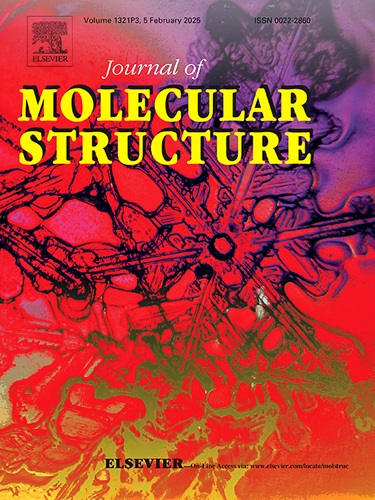Substituted bisbenzimidazole derivatives as multiple targeting agents to treat Alzheimer's disease, diabetes, and microbial infections
IF 4
2区 化学
Q2 CHEMISTRY, PHYSICAL
引用次数: 0
Abstract
This study presents the synthesis and bioactivity screening of a series of substituted bisbenzimidazoles (3a–l), assessed for their inhibitory effects on α-glycosidase, α-amylase, acetylcholinesterase (AChE), butyrylcholinesterase (BChE), as well as their antibacterial activities and metal chelation properties. Compound 3e exhibited the most significant inhibitory activity against intestinal α-glycosidase and α-amylase, showing IC50 values of 15.51 µM and 18.18 µM, respectively. All bisbenzimidazole derivatives demonstrated significant inhibitory activities, with Ki values between 0.99 and 2.98 nM for AChE and 0.40 to 2.18 nM for BChE. Antimicrobial analyses revealed significant antibacterial efficacy in compounds 3c and 3f, with IC50 values ranging from 10.75 to 12.83 μg/μL. This article presents a thorough evaluation of the pharmacological activities associated with bisbenzimidazole compounds 3a–l. To validate experimental results, selected compounds exhibiting notable enzyme inhibitory potential were subjected to molecular docking studies, which demonstrated their binding interactions within the active sites of target enzymes. Molecular dynamics simulation studies were carried out for 100 ns to determine the stability of the compounds in target proteins. During the simulation, it was observed that 3 h, 3 g, 3l, and 3e were stable in 4EY7, 4BDS, 3TOP, and 2QV4, respectively. Compounds 3 h, 3 g, 3e, and 3l have been identified as promising candidates for the inhibition of AChE, BChE, α-glycosidase, and α-amylase, respectively.
作为多靶点药物治疗阿尔茨海默病、糖尿病和微生物感染的取代双苯并咪唑衍生物
本研究介绍了一系列取代的双苯并咪唑(3a-l)的合成和生物活性筛选,评估了它们对α-糖苷酶、α-淀粉酶、乙酰胆碱酯酶(AChE)、丁酰胆碱酯酶(BChE)的抑制作用,以及它们的抗菌活性和金属螯合特性。化合物 3e 对肠道 α-糖苷酶和 α-淀粉酶具有最显著的抑制活性,IC50 值分别为 15.51 µM 和 18.18 µM。所有双苯并咪唑衍生物都具有显著的抑制活性,对 AChE 的 Ki 值介于 0.99 至 2.98 nM 之间,对 BChE 的 Ki 值介于 0.40 至 2.18 nM 之间。抗菌分析表明,化合物 3c 和 3f 具有明显的抗菌功效,IC50 值介于 10.75 至 12.83 μg/μL 之间。本文全面评估了双苯并咪唑化合物 3a-l 的药理活性。为了验证实验结果,对所选的具有显著酶抑制潜力的化合物进行了分子对接研究,以证明它们在目标酶活性位点内的结合相互作用。分子动力学模拟研究持续了 100 ns,以确定化合物在目标蛋白质中的稳定性。在模拟过程中,观察到 3 h、3 g、3l 和 3e 分别在 4EY7、4BDS、3TOP 和 2QV4 中保持稳定。化合物 3 h、3 g、3e 和 3l 分别被确定为有望抑制 AChE、BChE、α-糖苷酶和 α-淀粉酶的候选化合物。
本文章由计算机程序翻译,如有差异,请以英文原文为准。
求助全文
约1分钟内获得全文
求助全文
来源期刊

Journal of Molecular Structure
化学-物理化学
CiteScore
7.10
自引率
15.80%
发文量
2384
审稿时长
45 days
期刊介绍:
The Journal of Molecular Structure is dedicated to the publication of full-length articles and review papers, providing important new structural information on all types of chemical species including:
• Stable and unstable molecules in all types of environments (vapour, molecular beam, liquid, solution, liquid crystal, solid state, matrix-isolated, surface-absorbed etc.)
• Chemical intermediates
• Molecules in excited states
• Biological molecules
• Polymers.
The methods used may include any combination of spectroscopic and non-spectroscopic techniques, for example:
• Infrared spectroscopy (mid, far, near)
• Raman spectroscopy and non-linear Raman methods (CARS, etc.)
• Electronic absorption spectroscopy
• Optical rotatory dispersion and circular dichroism
• Fluorescence and phosphorescence techniques
• Electron spectroscopies (PES, XPS), EXAFS, etc.
• Microwave spectroscopy
• Electron diffraction
• NMR and ESR spectroscopies
• Mössbauer spectroscopy
• X-ray crystallography
• Charge Density Analyses
• Computational Studies (supplementing experimental methods)
We encourage publications combining theoretical and experimental approaches. The structural insights gained by the studies should be correlated with the properties, activity and/ or reactivity of the molecule under investigation and the relevance of this molecule and its implications should be discussed.
 求助内容:
求助内容: 应助结果提醒方式:
应助结果提醒方式:


